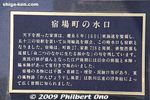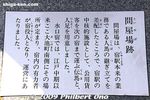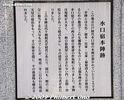Minakuchi-juku and Minakuchi Castle 水口宿・水口城
|
Title   • File Name • File Name   • Date • Date   • Position • Position   |
|

Minakuchi-juku was the fiftieth of the fifty-three stations of the Tokaido Road. The most prominent remnant is Minakuchi Castle. Short walk from Minakuchi Jonan Station and Minakuchi Ishibashi Station on the Omi Railway Line.Omi Railway Line at Minakuchi Ishibashi Station platform, the closest station to Minakuchi-juku.
|
|

Inside Minakuchi Ishibashi Station, somewhat rundown.
|
|

Minakuchi Ishibashi Station. When you exit, go right until you see the train tracks on the right. Cross the tracks and you will be heading toward Minakuchi-juku.
|
|

After crossing the train tracks, you see this forked intersection. The road forks into three roads. The one in the middle is the old Tokaido Road. There is also a monument.
|
|

The monument takes the shape of a hikiyama float. It contains a clock inside. MAP
|
|
|

This plaque shows a woodblock print by Hiroshige depicting Minakuchi-juku. (A clearer image of this print is shown below.)
|
|

Hiroshige's woodblock print of Minakuchi (51st post town on the Tokaido) from his "Fifty-Three Stations of the Tokaido Road" series. A summer scene of a few women drying gourd shavings to make kanpyo.
|
|

In 1601, Minakuchi-juku was designated as the 50th stage or post town on the Tokaido Road. It had 718 households. By the late Edo Period, Minakuchi had over 40 inns as well as a Honjin. Today, Minakuchi is one of the main populated areas of Koka.
|
|

Old Tokaido Road.
|
|

Near the forked intersection is Daitokuji Temple. Originally a Zen temple, it now belongs to the Jodo-shu sect. When Tokugawa Ieyasu passed through and visited the temple, he renamed it Daitokuji. 大徳寺
|
|

Daitokuji Temple gate
|
|

Daitokuji Temple's founding priest was an uncle of Honda Tadakatsu (Heihachiro), one of Tokugawa Ieyasu's important generals. Due to this connection, Ieyasu lodged in Minakuchi on his way to Kyoto and visited Daitokuji.
|
|

Daitokuji Temple Hondo Hall. Ieyasu donated land to the temple as well as a tree. He even created the temple's crest and renamed the temple to Daitokuji.
|
|

Daitokuji Temple Hondo Hall.
|
|

Jizo statues next to the Daitokuji Temple Hondo Hall.
|
|

Rock with Buddha's footprints.
|
|

Monument for the rock which Ieyasu sat on.
|
|

This is the rock which Tokugawa Ieyasu sat on when he visited the temple in May 1600. He sat on it while talking to the temple priest. Anyone can now sit on it. Called Tokugawa Ieyasu koshi-kake ishi. It was moved here in 1900. 腰掛石
|
|

A famous tree at Daitokuji.
|
|
|
|

Walk a little further east and north to visit the former Minakuchi Public Library designed by William Vories and built in 1928.
|
|

Former Minakuchi Public Library is next to Minakuchi Elementary School. 旧水口図書館
|
|
|

Entrance to the former Minakuchi Public Library has Romanesque columns.
|
|

Staircase inside former Minakuchi Public Library.
|
|
|

Inside former Minakuchi Public Library. Now it is sometimes used as an art gallery.
|
|

About Vories.
|
|

Walk further along and there is this path to Daikoji temple.
|
|

Daikoji temple was founded in 684 by priest Gyoki (行基) who installed a wooden Thousand-Arm Kannon statue (now missing). 大岡寺
|
|

Daikoji temple. The current building was reconstructed in 1715. It is one of the 33 temples on the Saigoku Pilgrimage in western Japan. 大岡寺
|
|

According to NHK in Oct. 2013, the whereabouts of two Important Cultural Property Buddhist statues from Daikoji temple in Koka are unknown. Reported to be have been stolen & sold.
|
|

Daikoji temple's bell tower. 「木造千手観音立像」と「木造阿弥陀如来立像」は寺の関係者が勝手に持ち出したあと第三者に売り渡された。
|
|

Basho Matsuo Haiku monument at Daikoji temple.
|
|

Monument for Iwaya Ichiroku, a noted calligrapher hailing from Minakuchi.
|
|

Pond for the souls of fish offered to the temple.
|
|

Old Tokaido Road
|
|

Another intersection.
|
|
|

Another clock monument
|
|

This is the site of Minakuchi-juku's Toiyaba which was like a travel logistics office and lodging reservations agency. Staffed by one or more people, it handled horses, messengers, luggage, helpers, etc. 問屋場
|
|

About Minakuchi-juku's Toiyaba.
|
|

A more traditional-looking part of the former Tokaido Road.
|
|

Here and there along the way, you'll see storehouses for the hikiyama floats. During the Minakuchi Hikiyama Matsuri festival on April 19-20, they are taken out to be decorated before being paraded to Minakuchi Shrine.
|
|

Nearing the end of Minakuchi-juku.
|
|

At the east end of Minakuchi-juku is the spot where the Kosatsu bulletin board stood.
|
|

This is a reconstruction of the Kosatsu bulletin board which displayed official notices from the shogunate. These bulletin boards were placed where many people passed by so they can stop and read the bulletins. 高札場
|
|

Sample bulletins on the Kosatsu bulletin board. That's a lotta fine print...
|
|

Not far from the Kosatsu bulletin board was Minakuchi-juku's Honjin. Nothing remains of the Honjin. This is the entrance to where it was located. 本陣跡
|
|

The Honjin was the town's most exclusive lodge reserved for daimyo lords, government officials, and even Emperor Meiji who once stayed here as this monument indicates.
|
|

Monument indicating that Emperor Meiji who stayed here in 1869. He was the last guest since the Honjin was then closed and dismantled. The Waki-Honjin was also nearby, but no signs.
|
|

About Minakuchi's Honjin.
|
|

Further east is the Higashi-Mitsuke Gate.
|
|

Reconstructed Higashi-Mitsuke Gate. 東見附跡
|
|

The Higashi-Mitsuke Gate was like the town's checkpoint with security guards posted watching people entering the town. There was another checkpoint on the west end of the town.
|
|

About Higashi-Mitsuke Gate. After reaching this gate, you might as well backtrack back to the train station.
|
|

This is the hill where the Minakuchi-Okayama Castle was originally built in 1585 by Nakamura Kazuuji 中村一氏, a vassal of Toyotomi Hideyoshi. It fell into ruin after the Battle of Sekigahara where the castle lord lost.
|
|

Old Tokaido Road in Minakuchi
|
|

Minakuchi Hikiyama float storehouse
|
|

After reaching Higashi-Mitsuke Gate, backtrack back to the train station and cross the train tracks to the other side of the Tokaido Road. You will be heading toward Minakuchi Castle. Minakuchi manhole. Shiga Pref.
|
|

A short walk from Minakuchi Ishibashi Station is Minakuchi Chubu Community Center.
|
|

This Community Center also houses a hikiyama float.
|
|
|

A detour on the old Tokaido road.
|
|

A detour on the old Tokaido road, created due to the castle grounds.
|
|

Minakuchi Christian Church designed by Vories. 水口教会会堂
|
|

Minakuchi Christian Church designed by Vories and built in Nov. 1930.
|
|
|
|

Way to Shintokuji temple. 真徳寺
|
|

This front gate at Shintokuji temple was moved from a lord's residence within Minakuchi Castle. 真徳寺
|
|

Shintokuji temple. 真徳寺
|
|

Minakuchi Stone at this corner is nicknamed Chikara Ishi (Stone of Strength) and was made famous by a woodblock print during the Edo Period. 力石
|
|

About Minakuchi Stone
|
|

Local shrine 五十鈴神社
|
|
|

A tree shows where the Ichirizuka marker was. It served as a milestone and distance marker for travelers.
|
|
|

Saw this along the way to Minakuchi Castle.
|
|

Stone monument commemorating the formation of Koka upon the merger of neighboring towns. (Minakuchi, Koka, Shigaraki, Konan, Tsuchiyama)
|
|

Minakuchi Castle was originally built in 1634 as a rest place for shogun Tokugawa Iemitsu during his travels to and from Kyoto. But the shogun stayed at the castle only once.
|
|

The castle later became the residence of the Minakuchi clan in 1682 headed by Lord Kato Akitomo. MAP
|
|
|
|
|
|
|

Bridge to Minakuchi Castle.
|
|

Minakuchi Castle Museum is open 10 am to 4 pm, closed on Thursday and Fri. 水口城資料館
|
|
|
|
|

Inside Minakuchi Castle Museum 水口城資料館
|
|
|
|
|
|

The only part of the castle that looks like a castle is the small, rectangular area (connected by a short bridge) seen on the left side of the map. The large square area on the right is now an athletic/sports ground as you can see in the next picture.
|
|

The Honmaru (main keep) is now the sports ground for Minakuchi High School.
|
|

Now we are approaching Minakuchi Shrine.
|
|

Minakuchi Shrine torii
|
|

Minakuchi Shrine torii 水口神社
|
|

Minakuchi Shrine decorated for the Minakuchi Hikiyama Matsuri festival on April 19.
|
|

Minakuchi Shrine
|
|

Minakuchi Shrine
|
|

Minakuchi Shrine
|
|

Near Minakuchi Shrine are these storehouses for hikiyama floats.
|
|

Minakuchi Public Library and folk history museum. 水口歴史民俗資料館
|
|

An early map of Minakuchi-juku.
|
|

1: Honjin, 2: Waki-Honjin, 3: Kosatsu bulletib board. Daikoji temple can also be seen on the upper left.
|
|

The museum also exhibits an actual Minakuchi Hikiyama float used in the annual Minakuchi Hikiyama Matsuri festival during April 19-20. One of the 16 floats is displayed here every year.
|
|

Inside Minakuchi Folk History Museum
|
|
|
|

Pilgrimage clothing
|
|

Pieces from Minakuchi Okayama Castle ruins.
|
|

Old map of Minakuchi Castle
|
|

Roof tile from Minakuchi Castle
|
|

Minakuchi-juku documents
|
|

Woodblock prints which depict Minakuchi.
|
|
|

Pipes
|
|

Pipe engraved with "Minakuchi."
|
|

Minakuchi Jonan Station on the Omi Railway Line. The library, museum, Minakuchi Castle, and Minakuchi Shrine are near this station.
|
|

Hikiyama Festival Plaza in front of Minakuchi Jonan Station.
|
|

Kibukawa Station, terminus of the Omi Railway Line and connection to the JR Kusatsu Line.
|
|
|
|
|